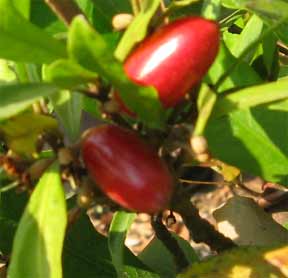This palm is also known as Toddy palm, Sugar palm, ताडगोला (Tadgola) and तालवृक्ष (Talvriksha) in Sanskrit. This palm is native to India and has several uses. Its references are available in ancient literature. In fact many ancient scriptures were written, and are still available, on leaves of the same tree. This palm is unisexual, that is a male and female flowers are found on separate individuals. Most parts of the tree are used. Leaves are used for making many useful and novelty items. In Tamilnadu I had seen the large leaf stalks being made in to brushes and brooms. Leaves are used to thatch the huts. Trunks of dead trees are used as columns for huts. Neera and Toddy are extracted from the inflorescence of this tree. Neera from the female tree is said to be sweeter than that of the male tree.
 |
| Male & female trees |
 |
| Male inflorescence |
 |
| Female inflorescence |
 |
| Fruit seller in Mumbai |
Unlike coconut palms, which tend to grow crooked trunks, this palm normally has absolutely erect stem. Its leaves are of fan shaped and the crown looks almost spherical. Tender fruits of this palm contain jelly-like kernel is 3 parts. Each individual section is covered with paper thin skin. Each section contains sweet nectar. If the fruits mature then the Kernels become rubbery and the nectar disappears. Absolutely ripe oozes yellow and stinking juice. The seeds of this mature fruit can be used to propagate new palms. Some years ago I had sown a seed of this palm which took more than a year to sprout.
 |
| Ripe fruit |
 |
| Seed |
It is a favourite tree of Baya birds to hang their nests from. In fact fibers of the leaves of this palm or of the coconut leaves are normally used by these birds to weave their wonderful nests. Earlier when vultures very in plenty, they used to roost on these trees. Due to their heavy weights and their droppings many Palmyra palms used to get deformed leaves.
 |
| Baya nests |
As the old leaves wither, they remain stuck to the trunks for months together. Gaps between leaf stalks and the trunk collect a lot of debris. Many Ficus species are found to be growing in these pockets. These Ficus plants grow there as a result of the birds' dropping, which eat Ficus figs. The Palmyra trees shelter and nourish these Ficus babies but as these Ficus grow larger, they anchor their roots in the ground and gradually cover the palm and finally strangle the palms to death. Such fig plants are called as 'Strangler figs'.
 |
| Strangler fig |
In Achrya Jagadish Chandra Bose Botanical Garden in Kolkata has a beautiful
avenue made of these trees. Scientific name of the palm is
Borassus flabellifer
and it belongs to Arecaceae family, to which all palms belong.
 |
| Avenue |


















































